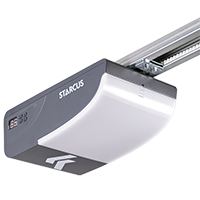We have recently discussed how to avoid mistakes associated with ordering your garage door. However, ordering a good garage door is not everything you have to consider. Its efficient and trouble-free operation is largely determined by its correct installation. Follow our tips, watch the video and see how to best prepare your garage for the installation of the door.

1. Finishing of the garage walls
Ideally, doors should be installed after the garage has been completely finished, since the installation of the door itself is an exceptionally “clean” process. This is not always possible, which is why we would like to focus your attention on these parts of the garage that are really crucial for the installation and which can be seen in the below illustration.
Lintels and jambs are important parts of the garage as the door structure is attached to them. They should be plastered and painted because access to them will be limited after the installation. They must also be straight and create a parallel plane. It ensures proper conditions for the correct installation of doors or a drive shaft. Otherwise, the distribution of forces in the mounted door will not be equal, which can lead to faster wear of the more loaded elements.
If you are going to paint the remaining walls of the garage after installing the door, remember to ensure adequate ventilation in the garage and aerate it as often as possible. This way you get rid of excess moisture from freshly laid plasters and paints and prevent it from settling on the door.
During any construction works, especially while painting the garage walls and finishing the exterior facade of the house, ensure maximum protection of the door against dust, as well as against plaster, mortar or paint splashing. Thoroughly secure the door with foil.
If paint or plaster gets on the door trim, first of all do not let it dry! As soon as possible gently remove any stains from the surface of the panels, and then wash them with a soft sponge using water and a mild cleaning agent.
2. Finishing of the garage ceiling
Remember to plaster the ceiling before the installation, because after the guides are fixed, its precise and even finishing will be difficult.
3. Nib insulation
When planning the insulation of the building walls, remember about the interior of the door nibs. Placing an insulation layer will prevent the formation of thermal bridges. Finishing nib insulation after the door has been installed without previous arrangements may affect the appearance of the door, e.g. it may pollute the seals or the edge of the glazing.


4. Preparation of the floor
If you avoid this mistake, you’ll achieve:
- best conditions for uninterrupted door operation,
- door tightness – no gap between the floor and the bottom panel of the door which protects against water or dust entering the garage, for instance.
Remember that determining the final floor level is necessary for fine adjustment of the door and programming the drive in terms of the door end positions, i.e. the position when it is fully open and fully closed. If the floor has not been poured before the door installation, service staff will have to be called again after that.
5. Preparation to the drive installation
Automatic doors are already standard. Of course, the drive can be mounted at a later stage of door operation, but it is worth preparing for it beforehand. It is very important to remember to lay the electrical installation for the drive, including a socket in the ceiling – before plastering the garage – this will help avoid later re-unravelling of the walls or ceilings.
The layout of the installation will depend on the type of the drive planned, as well as on add-ons selected, e.g. photocells or a key switch. It’s best to simply check the current automation offer with a professional contractor who will advise you to choose the solution that will be most convenient for you. You can find professional support at your nearest KRISPOL Trading Partner.
 Garage doors
Garage doors Facade garage doors
Facade garage doors Aluminium Side and garage doors
Aluminium Side and garage doors Rolling doors
Rolling doors Aluminium entrance doors
Aluminium entrance doors Sectional industrial doors
Sectional industrial doors Rolling grilles
Rolling grilles Rolling doors for industry
Rolling doors for industry Drives
Drives